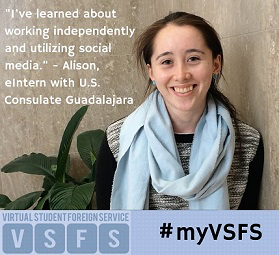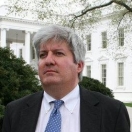
A important element of President Obama’s open-government strategy is expanding opportunities for the American people to participate in government. The Virtual Student Foreign Service (VSFS) program is doing just that. Since launching six years ago, VSFS has engaged thousands of eInterns (U.S. college students working remotely) to work on projects of global importance. Recently, I spoke with the State Department team that is running the program--Bridget Roddy, Nora Dempsey, and Asha Beh.

What is the Virtual Student Foreign Service program?
The U.S. Department of State’s Virtual Student Foreign Service (VSFS) program started out in 2009 as a way to harness technology and a commitment to global service among young Americans. It was also designed as a way to open doors to new forms of diplomatic engagement. Coordinated by the U.S. Department of State’s Bureau of Information Resource Management, VSFS now supports more than 25 U.S. Government agencies and departments, which benefit from the talent of hundreds of U.S. college students across the world.
What are the key elements of the Virtual Student Foreign Service program?
VSFS is an important citizen-engagement tool. Agencies benefit from being able to tap into an agile workforce—students with fresh ideas, new perspectives, and an abundance of creativity help our government work smarter, more effectively, and more efficiently. Students benefit from the experience and contacts they gain. VSFS interns do not need an agency-provided desk, phone, or security clearance. All they need is interesting and challenging work, plus consistent communication, to help the government move forward.
How many students and Federal agencies are currently participating in the program?
There are 750 students working on more than 320 projects in the current academic year. What began six years ago with 40 students completing projects in the U.S. Department of State has expanded into a program that every single government agency can draw from. The more projects, offices, and agencies involved, the more students we can reach and the more the Federal government can accomplish.
What are some examples of projects that students are currently working on?
Here’s a quick glance at some of the great projects our current virtual interns are working on (and you can find more on our Facebook page):
- Renewable Energy at NASA. Amy U., an Arizona State University undergraduate majoring in civil engineering and political science, is conducting research on renewable energy that can be used to power stations in harsh environments in high latitude and high altitude. As part of her project, she is also taking into account interdisciplinary questions, like how best to address communities that were built around coal mines and how switching energy sources will affect those communities.
- Countering H2-A Visa Fraud. Mark V., a civil-engineering major at Syracuse University, is working with the Consular section at the U.S. Embassy in Lima, Peru to help combat visa fraud. His project involves helping Peruvian sheepherders, who may fall victim to fraud when “coyotes” promise visas for large sums of money. Mark created a graphic comic to illustrate why the shepherds need to be wary of these “coyotes.” His overall goal as a VSFS intern is to create and analyze a digital map of U.S. sheep ranches, a project which will greatly assist visa officers who oversee the H2-A visa application process in Peru.
- Educational Advising and Communications Efforts at U.S. Embassies in Africa. Amy A., a student at George Mason University, has participated in VSFS for three years in a row. First, she worked with the EducationUSA team on educational advising via mobile technology in Sub-Saharan Africa. Next, she worked with U.S. Embassy Ghana, transcribing videos on the Embassy’s YouTube page and monitoring the Embassy website to ensure data accuracy and functionality. Currently, she is eInterning for the newly established Department of State U.S. Study Abroad office, where she created the Asian country fact sheets. She told us that the experience and knowledge gained in the first two VSFS experiences helped her obtain a traditional summer internship at State.
How do both students and Federal agencies benefit from participating in the program?
Every year, VSFS gives students a chance to apply what they are learning in school to help solve real-world challenges. They can also build a network of colleagues in government who can help and guide them with the “what’s next” after college. VSFS can help the government tap the expertise and creative ideas of students.
The fact that 25 other agencies are now participating in this State Department initiative pays off for everyone. By giving students with a wide variety of skills the opportunity to contribute to their government’s work, VSFS allows Federal employees to accomplish more without having to secure work space, funding, or a security clearance for an intern. Participating agencies include their projects with projects from the other agencies participating in VSFS so that students can see in one place all the VSFS opportunities across government, all managed by the State Department’s Office of eDiplomacy.
How would you like to see the program improve and expand over time?
Our first priority is to ensure that the U.S. college-student community knows that the U.S. Government needs them in every field, particularly at this moment, in the design and development of digital services. We have grown from one agency in 2009 to 25 in 2016 and we look forward to greeting every “knock, knock” on our open door with a warm “Come on in!” Agencies can do their own recruitment and outreach, if they want, or they can rely on our general outreach to students. We offer to help agencies set up their own program or give them the option of joining ours, and all have wanted to join ours thus far. It’s almost like we should be called the “Virtual Student FEDERAL Service”.
So to those agencies who want to join VSFS, email us at vsfs@state.gov or tweet @VSFSatState. To those students who are interested in applying, go to www.state.gov/vsfs and sign up to “Keep Me Informed” on the right side of http://careers.state.gov/. We look forward to working with you!
Tom Kalil is Deputy Director for Technology and Innovation at the White House Office of Science and Technology Policy.


